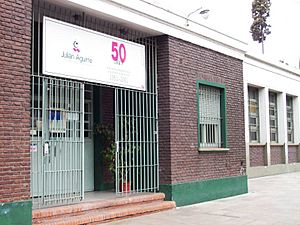Alberto Ginastera facts for kids
Quick facts for kids
Alberto Ginastera
|
|
|---|---|
 |
|
| Born |
Alberto Evaristo Ginastera
April 11, 1916 |
| Died | June 25, 1983 (aged 67) |
| Era | 20th Century |
| Signature | |
Alberto Evaristo Ginastera (April 11, 1916 – June 25, 1983) was a very important Argentinian composer of classical music. He is known as one of the most significant classical composers from the Americas in the 1900s.
Contents
Who Was Alberto Ginastera?
Alberto Ginastera was born in Buenos Aires, Argentina. His father was from Catalonia, Spain, and his mother was Italian. Later in his life, he liked to say his last name with a soft 'G' sound, like in 'George'. This was how it sounded in Catalan and Italian.
Ginastera studied music at the Williams Conservatory in Buenos Aires. He finished his studies there in 1938. After that, he became a young professor at the Liceo Militar General San Martín.
From 1945 to 1947, Ginastera visited the United States. There, he studied with a famous composer named Aaron Copland. When he returned to Buenos Aires, he took on many teaching jobs. Some of his well-known students included Ástor Piazzolla, Alcides Lanza, and Waldo de los Ríos. See: List of music students by teacher: G to J#Alberto Ginastera.
In 1968, Ginastera moved back to the United States. Then, in 1970, he moved to Europe. He passed away in Geneva, Switzerland, when he was 67 years old. He was buried in the Cimetière des Rois cemetery there.
What Kind of Music Did Ginastera Write?
Ginastera organized his music into three main periods. These periods show how his style changed over time.
- Objective Nationalism (1934–1948): In this early period, Ginastera often used traditional Argentinian folk music themes directly in his works.
- Subjective Nationalism (1948–1958): During this time, he still used Argentinian elements, but in a more abstract or hidden way.
- Neo-Expressionism (1958–1983): In his final period, his music became even more modern and expressive.
Many of Ginastera's pieces were inspired by the Gauchesco tradition. This tradition celebrates the Gaucho. Gauchos were skilled horsemen of the Argentinian plains. They are seen as a symbol of Argentina's spirit.
One of his interesting works is Cantata para América Mágica (1960). This piece is for a dramatic singer and 53 percussion instruments! It was based on old legends from before Christopher Columbus arrived in the Americas.
Important Musical Works
Ginastera wrote many different types of music. Here are some of his most famous works:
Operas
- Don Rodrigo, Op. 31 (1963–64)
- Bomarzo, Op. 34 (1966–67) - This opera was not allowed in Argentina until 1972.
- Beatrix Cenci, Op. 38 (1971)
Ballets
- Panambí, Op. 1 (1934–37)
- Estancia, Op. 8 (1941)
Orchestral Music
These are pieces written for a full orchestra.
- Obertura para el "Fausto" criollo, Op. 9 (1943)
- Variaciones concertantes, Op. 23 (1953)
- Concerto per corde (Concerto for Strings), Op. 33 (1965)
- Popol Vuh, Op. 44 (1975–1983) - This piece was not finished when he died.
Concertos
Concertos are pieces for a solo instrument with an orchestra.
- Harp: Harp Concerto, Op. 25 (1956–65)
- Piano:
- Piano Concerto No. 1, Op. 28 (1961)
- Piano Concerto No. 2, Op. 39 (1972)
- Violin: Violin Concerto, Op. 30 (1963)
- Cello:
- Cello Concerto No. 1, Op. 36 (1968)
- Cello Concerto No. 2, Op. 50 (1980–81)
Piano Music
- Danzas argentinas, Op. 2 (1937)
- Malambo, Op. 7 (1940)
- 12 Preludios americanos (12 American Preludes), Op. 12 (1944)
- Piano Sonata No. 1, Op. 22 (1952)
- Piano Sonata No. 2, Op. 53 (1981)
- Piano Sonata No. 3, Op. 54 (1982)
Vocal and Choral Music
These pieces are for singers or choirs.
- Psalm 150, for choir and orchestra, Op. 5 (1938)
- 5 canciones populares argentinas (5 Popular Argentinian Songs), for voice and piano, Op. 10 (1943)
- Cantata para América mágica, for dramatic soprano and percussion orchestra, Op. 27 (1960)
- Turbae ad passionem gregorianam, for soloists, chorus, and orchestra, Op. 43 (1975)
Chamber and Solo Instrumental Music
These are pieces for small groups of instruments or a single instrument.
- Duo, for flute and oboe, Op. 13 (1945)
- String Quartet No. 1, Op. 20 (1948)
- Pampeana No. 2, for cello and piano, Op. 21 (1950)
- String Quartet No. 2, Op. 26 (1958, revised 1968)
- Piano Quintet, Op. 29 (1963)
- String Quartet No. 3, for soprano and string quartet, Op. 40 (1973)
- Sonata for guitar, Op. 47 (1976, revised 1981)
Music for Films
Ginastera also wrote music for movies and plays. Here are a few examples:
- Don Basilio malcasado (1940)
- Malambo (1942)
- Rosa de América (1945)
- Facundo, el tigre de los llanos (1952)
Discography
Many of Ginastera's works have been recorded. Here are some of the recordings:
- Bomarzo, The Opera Society of Washington, Julius Rudel, conductor; 1967 recording re-released on Sony Classical in 2016.
- Cantata para América Mágica, Raquel Adonaylo, soprano; Los Angeles Percussion Ensemble, William Kraft, conductor. Columbia Masterworks MS 6447. New York: Columbia Records, 1963.
- Complete works for piano, Andrzej Pikul (piano), Dux Recording Producers, 2007.
- Flores Argentinas: Canciones de Ginastera y Guastavino / Inca Rose Duo: Annelise Skovmand, voice; Pablo González Jazey, guitar. Cleo Productions, Cleo Prod 1002, 2007.
- Nissman Plays Ginastera: The Three Piano Concertos. Barbara Nissman, piano; Kenneth Kiesler, conductor; University of Michigan Symphony Orchestra. (CD) Pierian 0048 (2012).
- Popol Vuh – The Mayan Creation, Estancia, Panambi, Suite de Danzas Criollas, Ollantay. Gisele Ben-Dor, conductor. London Symphony Orchestra, Jerusalem Symphony Orchestra, BBC National Orchestra of Wales. Naxos, 2010.
- Panambi, Estancia (complete Ballets), Gisele Ben-Dor, conductor. Luis Gaeta, narrator/bass baritone. London Symphony Orchestra. Naxos, 1998 & 2006.
- String Quartets – "Ginastera: String Quartets," Cuarteto Latinoamericano, with Claudia Montiel, soprano [Elan 82270].
See also
 In Spanish: Alberto Ginastera para niños
In Spanish: Alberto Ginastera para niños


